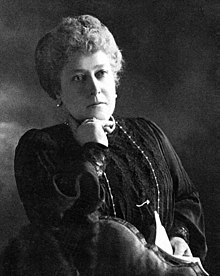Princess Christian of Schleswig-Holstein
| Princess Helena | |||||
|---|---|---|---|---|---|
| Princess Christian of Schleswig-Holstein | |||||
 |
|||||
| Born |
25 May 1846 Buckingham Palace, London |
||||
| Died | 9 June 1923 (aged 77) Schomberg House, London |
||||
| Burial | Frogmore, Windsor, Berkshire | ||||
| Spouse |
Prince Christian of Schleswig-Holstein (m. 1866–1917; his death) |
||||
| Issue |
Prince Christian Victor Albert, Duke of Schleswig-Holstein Princess Helena Victoria Princess Marie Louise Prince Harald |
||||
|
|||||
| House | Saxe-Coburg and Gotha | ||||
| Father | Albert, Prince Consort | ||||
| Mother | Queen Victoria | ||||
| Full name | |
|---|---|
| Helena Augusta Victoria |
Princess Helena (Helena Augusta Victoria; Princess Christian of Schleswig-Holstein by marriage; 25 May 1846 – 9 June 1923) was the third daughter and fifth child of Queen Victoria and Prince Albert.
Helena was educated by private tutors chosen by her father and his close friend and adviser, . Her childhood was spent with her parents, travelling between the variety of royal residences in Britain. The intimate atmosphere of the royal court came to an end on 14 December 1861, when her father died and her mother entered a period of intense mourning. In the early 1860s, Helena began a flirtation with Prince Albert's German librarian, Carl Ruland. Although the nature of the relationship is largely unknown, Helena's romantic letters to Ruland survive. After the Queen found out in 1863, she dismissed Ruland, who returned to his native Germany. Three years later, on 5 July 1866, Helena married the impoverished German Prince Christian of Schleswig-Holstein. The couple remained in Britain, in calling distance of the Queen, who liked to have her daughters nearby, and Helena along with her youngest sister, Princess Beatrice, became the Queen's unofficial secretary. However, after Queen Victoria's death on 22 January 1901, Helena saw relatively little of her surviving siblings.
Helena was the most active member of the royal family, carrying out an extensive programme of royal engagements at a time when royalty was not expected to appear often in public. She was also an active patron of charities, and was one of the founding members of the Red Cross. She was founding president of the Royal School of Needlework, and president of the Royal British Nurses' Association. As president of the latter, she was a strong supporter of nurse registration against the advice of Florence Nightingale. She became the first member of her family to celebrate her 50th wedding anniversary in 1916, but her husband died a year later. Helena outlived him by six years, and died aged 77 at Schomberg House on 9 June 1923.
...
Wikipedia
